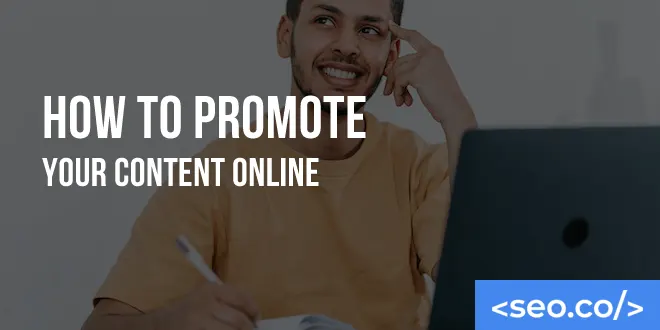In order to win in online marketing, your content marketing strategy should include at least (perhaps more) two easy steps:
- Create great onsite content with content marketing (which we have discussed at length before)
- Promote that onsite content.
This ultimate guide to promoting your published content is all about the other side of the equation—the side that gets neglected by most content marketers.
Everyone knows the importance of content promotion (otherwise, you’d have no “content”), but for many marketers, that’s the end of the line. Once a piece is created, your job is pretty much done, right?
Wrong. In fact, the tactics you use to promote and nurture your published content have just as big of an impact on your overall results as the quality of your content in the first place. Without a proper follow-up strategy, even your best content strategy might fail to live up to its true potential.
In this guide, I’ll explain the concept of promotion and nurturing, why it’s important for any digital marketing strategy, and of course, the specific tactics you’ll need to leverage in order to maximize your content’s visibility. As usual, this guide (like our other definitive guides) is broken up into clear sections, so feel free to jump around to the sections that matter most to you and your brand.
Table of Contents
Lead Nurturing is the goal of quality content promotion
Getting your content seen by more people is a big part of your promotion and nurturing strategy, but that isn’t the only goal.
There are many benefits to promoting and nurturing your material, which manifest differently depending on what you’re promoting and how you’re promoting it:
- Increased visibility
- Rejuvenated interest
- Maximizing efficiency
- Lead generation
- Sales
Types of content promotion
Throughout this ultimate guide to promoting your published content, I’m going to be walking you through the many types of content promotion that you can engage in.
These vary from free to expensive, from easy to hard, from temporary to long-term, and offer many different advantages and disadvantages between them.
I encourage you to familiarize yourself with each approach, and decide on an individual basis whether or not each one is right for your brand. Some brands may wish to use all these content promotion strategies in conjunction with each other, complementing all their strengths and weaknesses at once, while others may wish to focus on the one or two most likely to bring them rankings in search engine results pages (SERPs).
In any case, here’s a briefer on where this guide is going from here:
- Social media.
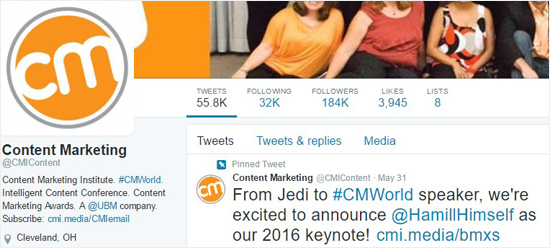
(Image Source: Twitter)
- Email marketing.
- Influencer marketing.
- Links.
- Social bookmarks.
- Paid advertising.
- Transformations.
Social Media Syndication and Engagement
First up, we have the strategy that almost everyone thinks of first when it comes to content promotion: social media syndication.
Why is social media syndication so popular? Because it’s free, relatively easy to use, and it offers the potential of exponential growth. Ideal for both one-time and long-term content runs, I highly encourage social media distribution at a bare minimum for every brand. Let’s explore the reasons why, and how to use social media advertising effectively.
Choosing the right content promotion platforms
One thing, understand that social media marketing isn’t a magical gateway to more visibility and a bigger target audience. Some platforms are going to matter to your brand far more than others, and it’s up to you to decide which ones those are. It’s not an easy decision, nor is it necessarily straightforward, but narrowing your scope of content syndication to only the platforms that are most effective initiatives for your brand can help you maximize your return while cutting back on wasted time.
- Demographic considerations. Your first job is to take a look at the demographic makeup of each platform, and weed out any platforms that aren’t a good fit for your brand. There’s basic information, such as age groups of users (Snapchat, for example, tends to skew toward teenagers and young adults), but also more behavioral and qualitative information to consider (LinkedIn, for example, is mostly used by working professionals). Other platforms, like Facebook, have a broad appeal and are worth pursuing for almost any business strategy. If you’re looking for a good all-in-one source for social media demographic information, Pew Research has a fantastic breakdown.
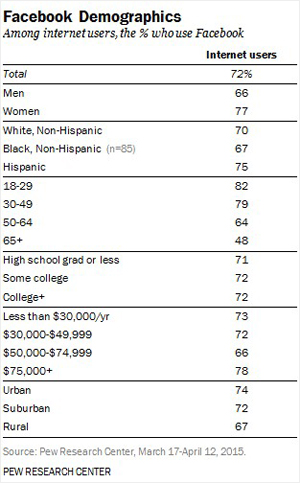
(Image Source: Pew)
- What are your main goals?
- What does your target audience want?
- What are your competitors doing?
- What would complement this platform type?
Initial content promotion

Once you’ve got a loose strategy set in place, and a good understanding of what types of content promotion you’ll be pursuing, you can begin. Ultimately, there are two ways to promote your content in the social sphere, and the first is with initial content promotion.
Facebook allows you to boost your posts (for a price) so they reach more of your target audience, and this can be a great way to get an initial boost of syndication with your audience.
LinkedIn groups offer another great channel for getting initial visibility. Start by joining as many LinkedIn groups as you can that are relevant to your industry or business (as of time of writing, the limit is 50 groups per account). Once you’re accepted into the groups, participate in them and add your content to them as discussions.
Ongoing content syndication
The other route for social media distribution is ongoing syndication. Here, you’ll be reposting your older pieces of content on a recurring basis. Obviously, newer content is better, but syndicating your old material will help it be seen by people who missed it the first time around and may re-spark interest in your older concepts. Plus, you need to be posting almost constantly if you want to stay relevant in social media—and your archive of content can help you do it.
- Timing considerations. There are a couple types of timing considerations you’ll need to bear in mind here. First, it’s not a good idea to repost your latest material the day after you initially promoted it. Instead, wait at least two weeks, preferably a month or longer, before distributing it again. This will help you avoid appearing too repetitive. Re-posting content on social media is beneficial, but it must be done strategically.
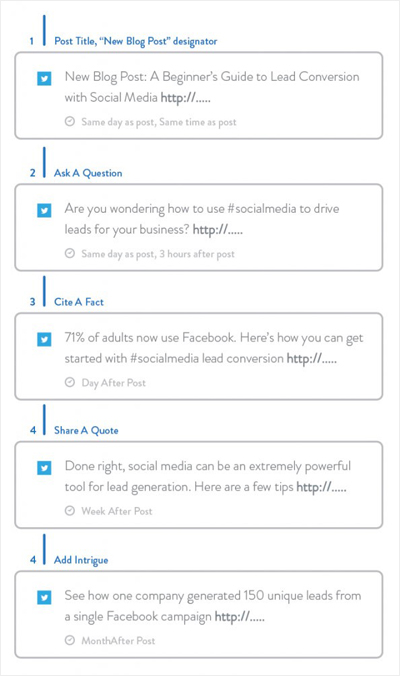
(Image source: Kissmetrics)
Second, you’ll need to make sure your streams of content posts are timed appropriately for each platform. For example, your Twitter users probably wouldn’t mind seeing you posting five times per day or more, but your Facebook users wouldn’t be nearly as happy about that. Find a rhythm that works for your target audience and platform of choice.
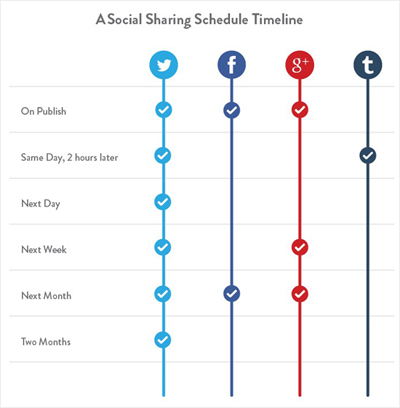
(Image source: Kissmetrics)
- Renaming and reframing. To seem fresher and less repetitive, it’s a good idea to retitle your work, or at least reframe it in a different context. For example, my example in the previous section led into an article with the phrase, “this is the last post you’ll ever need for your content marketing strategy—find out how the pros do it!” Adjusting it to something like “Your content promotion strategy is about to be transformed—check out these new amazing tactics!” will generate more interest and fewer eyerolls.
Discussion encouragement

On social media, you’ll also want to take the time to spark discussions. Having more users talking about your post will bring more attention to it, as it will likely rank higher in subscribers’ newsfeeds and become visible to extended followers of people engaged in the discussion. Here are three ways to do this:
- Spark debate. Your first option is to spark a debate—and you know the Internet loves a good debate. As a first-line measure, you can write and syndicate topics that are naturally debatable, such as strong stances on industry developments or (if you’re respectful about it) political and economic issues.
- Encourage anecdotes. You can also ask the crowd for anecdotes or examples that either confirm or deny the strength of your material.
- Ask for feedback. Finally, on a meta level, you can ask your users for feedback. A simple question like “what did you guys think of our latest webinar?” can instantly bring you a host of user comments (provided it was impactful enough).
Content Promotion with Email Marketing
Your next method for content promotion is a similarly inexpensive one, with a similar path to potential growth.
Start collecting subscribers for your email newsletter on the sides and footer of your website. The more subscribers you have, the more powerful this distribution channel is going to be.
Essentially, you have two potential angles for email marketing: regular newsletters or exclusive offers and editorial calendar. Feel free to include both angles in the same email blast, cover them separately, or cover just one or the other.
Regular content newsletters
The idea behind a regular newsletter and blog post is to take pieces of content, presumably from your on-site blog, and promote them via an occasional email blast.
As a content promotion tactic this will increase the visibility of your content and give your subscribers – who are already familiar with your brand and content – a chance to read, share, and engage with them. For example, consider this email blast which promoted one of our recent blog posts:
- Timing. There are various studies that suggest different timings for email newsletters initiatives are the “most effective,” but as you can probably guess, the answer’s going to be different for every brand.
- Selection criteria. You’ll need to include at least one post in your newsletter, obviously, but generally you’ll want to include a handful—maybe three to five, with one post taking center stage. Which posts should you include? Which one should get top billing?
- Engagement and links to other strategies. You’ll want to include engagement opportunities in the body of your email, including calls to action that encourage readers to “read more” by clicking through to your site. It’s also a good idea to have immediate social share and/or comment icons that allow your subscribers to engage with your material right away.
Email marketing functions well as a standalone for some businesses, but it’s most effective when it’s used to promote and complement your content and social media strategies.
Promoting Content with Influencer Marketing
Influencer marketing has some of the greatest overall potential of any of the content promotion strategies on this list.
One of the best options you have to appeal to an influencer is to cite them in the body of a piece of content you’ve written, this shows that you’re sincerely interested in their material, gives them a benefit, and gives you an excuse to contact them, all in one. The goal is to have them see this citation, and then share the piece of content with their followers.
- Possible angles of approach. There are a few different ways you can approach this. For example, you could take the pure complimentary approach and merely inform them how much you loved their previous work, hoping that they’ll respond in kind and share your material. You could also be more direct and ask them to share it if they think the content is valuable—this is especially powerful if you’ve added something new to the conversation.
- The email copy. The easiest way to reach most influencers is via email, but there’s a downside to this medium—most influencers get hundreds, if not thousands of emails every day. If you want to be successful, make sure you stand out by being direct, specific, concise, and friendly.
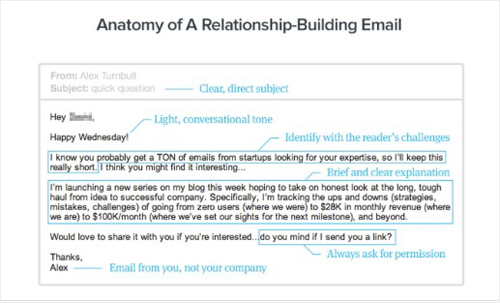
(Image Source: Kissmetrics)
- The casual mention. If you want to forgo the email route altogether, you could instead opt for a casual mention on social media. Here, you’ll promote your content post as you normally would, but you’ll also tag the individual or authority you cited in the body of your work.
Asking for a quote or testimonial
The above set of content promotion strategies is ideal if you’ve already created a piece of content and you want to use an influencer to help promote it.
But you can also work with an influencer during the content development strategy & process to make your piece of content more powerful and influential from the beginning.
Here, you’ll reach out to an influencer in advance for some kind of contribution, usually a quote on a given topic or a testimonial to validate your approach.
- Appeal to the ego. Not all influencers are egomaniacs, but everybody likes to be complimented.
- Know who you’re asking. Every influencer has a different niche of expertise, and a different disposition when it comes to working with others on content.
- Make it a value exchange. When making your request, make sure to play up the fact that this isn’t a favor; it’s a value exchange.
- Use the appropriate medium. Not all influencers prefer to communicate in the same ways. See what you can do to find the best way to contact them.
After including their quote in the body of your work, be sure to notify them when it’s formally published—they’ll want to see your finished work, and they’ll probably either share it or link to it.
Finding known interested parties
Another angle to leveraging influencers for content promotion is to seek out authorities who you know have a vested interest in your topics.
You can either do this in a top-down, or bottom-up approach.
The top-down approach is to find an influencer with a vested interest in a particular topic or niche, then write a post you know he/she would be particularly interested in.
The bottom-up approach is to write a topic you like, then hunt for an influencer to match it.
There are merits to both approaches, but either way, you’ll have to find an influencer eventually.
- Active bloggers. One of the best ways to find an appropriate influencer is to search for active bloggers who have major followings. You can find these bloggers by searching for them directly via your topic of interest (on the web or on social media), or by finding them listed in directories or industry lists.
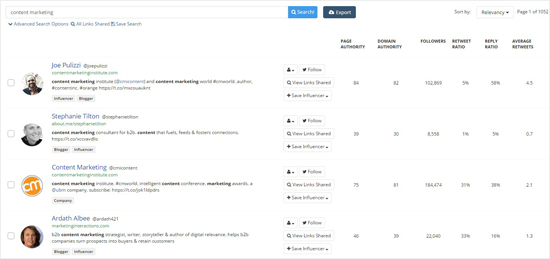
(Image Source: BuzzSumo)
- Solving problems. As part of a top-down approach, you can peruse an influencer’s blog and note areas where their content seems insufficient, or where their followers are in need of more information. You may even find the influencers/writers themselves explicitly mentioning how they wish they had more information in a particular area.
Finding known interested parties can be valuable, but it’s also somewhat limiting; by its nature, you’ll be more restricted in who you can contact, and you may have to reach out to influencers one at a time, stifling your potential at least slightly.
Content collaboration & exchange
A final option you have in working with influencers is forming a kind of partnership.
In some cases, this will manifest as a co-authorship, and in others it will merely be an exchange of favors, but either way you’ll be working directly with an influencer on material that promotes both of your content (or gives you both content marketing strategy that you can then produce).
There are two huge upsides to this method of influencer marketing for content marketing.
First, it automatically gives you knew content with a promotion system already in place. Who doesn’t want that?
Second, this method of work naturally lends itself to ongoing partnerships and relationships.
With it in place, you’ll be able to get at least one influencer in your corner and work with them on a number of projects in the future.
Inbound links & Internal Links
Another way to maximize the performance of your content is by building links—both external links pointing back to your domain and internal links in your own blogs cross-referencing your other posts.
The former is designed to increase your content’s organic search rankings, sending more blog traffic their way.
The latter is designed to keep your visitors on your site longer, while directing them to your best-performing content (not to mention further improving your on-site SEO).
Modern link building can be described as consisting of two main link building strategies: attracting links naturally with great content and building links manually (typically through a link building service).
Since attracting links naturally is a combination of producing great content and then promoting it (which is the focus of this guide), you’ll need to implement a manual link building outreach program.
Content Communities and Social Bookmarking
Bookmarking involves users submitting content to a central location, which can be browsed and accessed by a content-hungry public. This setup lends itself perfectly to brands trying to generate more attention for specific pieces of content on their sites.
To illustrate some of these best practices and provide direction for your prospective campaign, let’s take a look at a handful of examples in each area:
Reddit is a massively popular content discovery and social bookmarking site. Similar to StumbleUpon, users can submit pages they think are interesting, then browse and up-vote or down-vote content production they encounter. Submit content and engage with users in one of Reddit’s many “sub-Reddits,” dedicated to niche interests.

(Image Source: Reddit)
As a means of content promotion, Reddit has massively scaled their presence on Google in recent years.
It’s no longer just about bookmarking on Reddit, but engaging with and answering questions of Reddit users (i.e. talking to actual people) is paramount.
Medium
Medium is a content community but with a long history and a large user base. If you’re just starting to dabble in the world of content marketing or content communities, it’s a good place to start.
Again, the more specific an audience you target in your content promotion, the better.

(Image Source: Medium)
These aren’t the only social bookmarking or content community sites out there—not by a long shot—but they are good examples that can help you get brainstorming and possibly get started in this wing of content promotion.
Paid Advertising
For some, pay-per-click advertising can generate a positive ROI, but that ROI is capped and tied directly to the amount of money you’re putting in. In effect, paid advertising is inherently temporary; as long as you keep paying for it, you’ll be able to see a linear return of traffic.
Inbound marketing, on the other hand, relies on the creation of permanent assets and compounding growth, which means your content marketing ROI could increase indefinitely, and even if you taper your spending, you’ll still continue reaping the benefits.

That being said, paid advertising can be used as a way to promote your created content — especially if all you’re looking for is a short-term boost or to “seed” your new content with eyeballs.
If you choose to use paid advertising for your content promotion, I highly encourage you to hedge your bets with a number of other, more long-term investments in your brand visibility.
Options for Paid Advertising
You have a few main options when it comes to using paid advertising to support your content marketing strategy:
- Build a landing page for a major piece. This is best used for major, landmark pieces of content, like eBooks or reports on your original research. The concept is to create a dedicated page, offering your content as a downloadable digital asset in exchange for a bit of personal information (including an email address, which you can then feed into your email marketing strategy). This is effective because it promotes the value of your landmark piece and earns more subscribers for your email newsletter simultaneously. Because you’re reliant on new traffic and new subscribers to maximize the value here, paid advertising can be highly beneficial.
- Direct traffic to a guide or report. You could also use paid advertising to direct traffic to a certain page of your site, especially if it serves as a guide or tutorial. If that’s the case, you can specifically target search queries or users that imply a need for such a guide, guaranteeing a level of relevance with your target audience. You could also advertise a new report you’ve generated if it contains some original research; because your information will be time-sensitive, it’s worth the temporary paid boost.
- Indirect ties. Of course, you could also use paid channels to get people to your main site, or to a contact page or a landing page that simply promotes the brand. This won’t increase traffic or visibility for your content directly but could indirectly lead more people to your blog once they’re inspired to research your company, just like you may be motivated to research your competitors.
There are hundreds of options for paid advertising on the web, and even more if you count affiliate marketing and general banner ads. But for the sake of conciseness, I’m going to recommend only two heavy-hitting platforms for your campaign, and you can probably guess what they are—Google and Facebook.
Google Ads
Google Ads has been the name to beat in advertising for many years, and it’s little wonder why. It has some major advantages as an advertising platform:
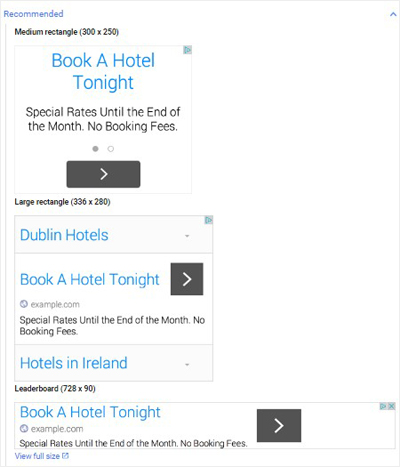
(Image Source: Google)
- Volume. Practically everyone you know uses Google search on a daily basis. Search engines are home to billions of searches every day, and even the strangest niche keywords are capable of generating hundreds of impressions on a daily basis.
- Keyword specificity. Google’s keyword research tools allow you to get extremely specific in terms of who you’re targeting. By selecting very specific keyword phrases, you can ensure a relevant fit for your content marketing efforts.
Facebook Ads
On the other hand, Facebook has developed its own content advertising platform in a way that challenges Google with a number of unique advantages of its own:

(Image Source: Facebook)
- Audience. Google has tons of search data, but Facebook collects data on people. It knows their demographic makeup, their friends, their likes and dislikes, and even some of their personal behaviors and tendencies. You can target these factors with extreme specificity, breaking free of the keyword grip.
- Competition and budget. Though Facebook ad participation is climbing higher and higher, it’s still not quite as competitive as Google AdWords. That means you’ll generally pay lower prices for your ads and face less stiff competition.
- Approachability. Though this is a purely subjective matter, I’ve found that most people view Facebook’s advertising platform as more approachable, or easier to learn than Google AdWords, which has a definite learning curve to its use.
Aside from paid ads, another feature which I mentioned earlier, but which is deserving of another mention, is Facebook post boosting. Facebook has shown a pattern of changing its algorithm to reduce the visibility of create content posted on brand pages, in an effort to get brands to pay for visibility in newsfeeds.
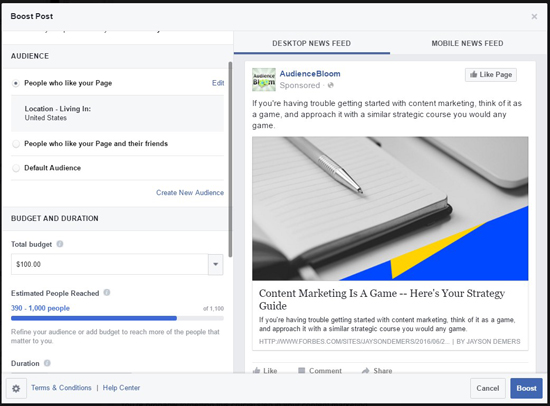
Google and Facebook each have their own advantages and disadvantages, so it’s up to you and the nature of your content production to decide which is best for your campaign. You might even choose to use both!
Sequels, Reboots, and Revisits
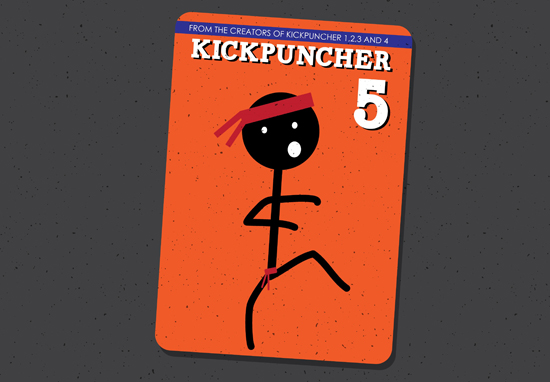
Transform your content to further nurture its growth and visibility by updating your content or performing content reboots.
Here’s how.
Content promotion via part of a series
Your first option is to turn your piece of content into a series; in other words, you’ll take the idea or format of that first post and expand it into a series of different posts. This is most effective when you have a topic you know has performed well—new parts of the series can capitalize on this popularity, simultaneously earning more immediate visibility and supporting both the past and future of the content series. There are a few ways you can do this.
- Individual components. You could take the general topic and apply it to more specific topics or change the specific focus of an article to another, related focus.
- Regular features. You could also make a regular feature that keeps some concept, idea, or format consistent across multiple posts. The best way to describe this is through an example—so take Moz’s Whiteboard Friday series. Every Friday, Rand Fishkin or another Moz expert uses whiteboard notes and doodles, along with a spoken monologue to describe and explore some specific topic related to search engine optimization (SEO) efforts. Again, because of its consistency, each new post adds value to all the posts that came before it and all the posts that will come after it.

(Image Source: Moz)
- Taking advantage. No matter what kind of angle you choose for your series, the true power of a series lies in reflection and anticipation. Every time you create a new post, try to generate anticipation for your next post with a tease or a preview, and link back to your past works in the series.
Content promotion via updating with new information
Rather than keeping up with an ongoing series, you could support one of your older posts by simply updating it with new information. For example, if you ran a survey in your industry in 2015 around this time, why not run a similar survey in 2016 to see what’s changed and what hasn’t?
In some contexts, this can serve as a long-term series, updated annually instead of monthly. But in other contexts, this could serve as a form of journalistic correction, or even the inclusion of new anecdotes and arguments. Making a new edit to an older piece gives you an excuse to market and distribute that piece all over again.
Content promotion via transforming into a new medium
As another method of transformation, you can take a piece of content that exists as one medium and transform it into another medium. In some cases, like video transcription, this will mean simply re-doing the material in another form, but in other cases, like generating an infographic from research data, this will require far more investment and creativity.
Creating content and documented content strategy within a new medium allows you to target new audiences, as some portions of the population have different content preferences than others. It’s particularly useful in targeting new platforms and syndication channels, such as generating an infographic so you can take advantage of Instagram.
- Text transcription. If your original piece of content is visual or audio-only, you can create a written transcription to include with it. This won’t necessarily open up doors to new syndication channels, but it will help you optimize your page for SEO and serve the hearing impaired.
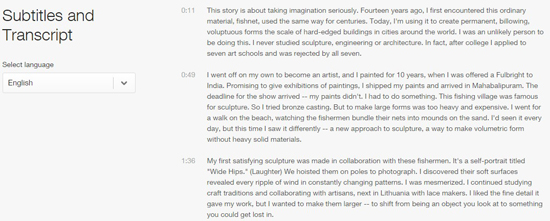
(Image Source: TED)
- Images. Translating written content to still images can be daunting, depending on the degree of effort you choose to put in it. Translating volumes of data into a single, digestible image demands significant imagination and work, but you don’t always need to go that far; consider offering simple doodles that illustrate your concepts and ideas. I often reference Tim Urban’s work over at WaitButWhy.com as examples, because he’s a natural-born digital marketing expert. But take a look at just about any of his posts and you’ll see hand-drawn graphs, charts, and silly cartoons that illustrate points and provide clarity to his written thoughts. Head over to his post on cryonics and scroll down to see some examples of how he uses charts and illustrations in his text-based posts.
- Audio. Audio is another format that’s always valid. If you have a video interview, for example, consider offering it as a downloadable MP3 file on your website. If you produce a stand-out piece of create content, consider recording yourself reading it out loud and offering it as an audio file.
- Video. Producing video content from another medium is probably the most effort-intensive transformation on this list, but considering the ever-increasing popularity of visual formats, it’s well worth the trouble. If you’re just starting out, try using Microsoft PowerPoint to create a slide deck that summarizes your content, then record your audio for each slide (which can be your voice using a microphone), then convert the presentation to a video using PowerPoint’s native conversion capability.
- Webinar. While you’re using PowerPoint, create a webinar. In fact, if you’ve created a slide deck and already recorded video content, you have a webinar! You can present your Webinar to a live audience, or you can record it and play back the recording to a live audience. The choice is yours! After your live webinar is over, be sure to make it downloadable/accessible via your website so people who missed it can still watch it down the line.
- SlideShare. After you’ve created a slide deck, post it to Slideshare for further reach.
- PDF. Possibly one of the simpler transformations on this list, you can also convert your blog post into downloadable PDF files, to make them available as standalone resources rather than web pages to browse. For an example of this, take a look at our guide to link building. At the top of the blog post, you’ll notice that we’ve got a message indicating that the post can be downloaded as a PDF eBook. You can convert Microsoft Word documents to PDF files natively, or you can find a designer (using Upwork or another freelance marketplace) to create PDFs as part of your holistic content promotion tactics.
PromoteYour Content!

In this guide, we have covered that organic search engine marketing is about visibility, reputation improvement, traffic, conversion rate optimization, and alternative marketing support, and you can’t achieve any of those if you create content exists in a vacuum. Online marketing and nurturing is your way to break out from that level of captivity.
There are so many options for content promotion and support, from maximizing initial reach to transforming and breathing new life into old pieces, that it’s virtually impossible to use all of them to support your strategy. Instead, try to specialize in a handful that seem to have the greatest impact for your brand. As always, you’ll need to experiment, measure your results, and refine your approach, but as long as you keep supporting your content production with more visibility and more potential for growth, you’ll continue increasing your effectiveness and maximizing your returns.
Remember, as an SEO reseller also that we also provide white label reseller support for online marketing campaigns and outreach for content promotion.
Feel free to take a look at our digital marketing & SEO reseller guide or get in touch with us today!
- How to Optimize Your Google Business Profile (GBP) to Improve Local SEO in 2025 - December 20, 2024
- Negative SEO: Is Negative SEO (aka “Google Bowling”) Still Real in 2025? - December 19, 2024
- Should You Be Using a Private Blog Network (PBN) for Link Building in 2025? - December 16, 2024

